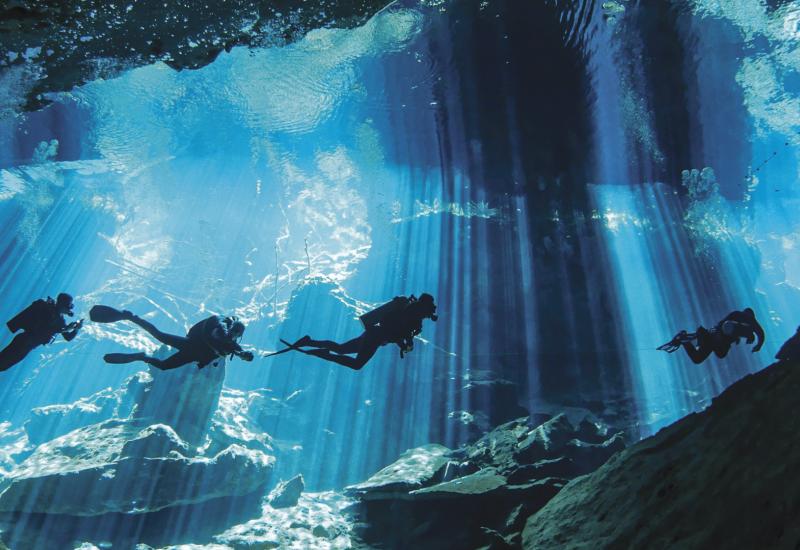Ask DAN: How Can I Stay Warmer Underwater?

Courtesy of DANCold water diving requires special equipment and training to ensure safety and comfort in colder conditions.
A person loses heat approximately 25 times faster in the water than on land, so it’s wise to be prepared for cold even when diving in temperate or tropical water.
Heat energy is transferred in four ways: conduction, convection, evaporation and radiation.
In conductive heat transfer, heat energy moves from a warmer object to a cooler object or medium in direct contact. A warm person on the cold boat deck is an example of this.
Convective heat loss also involves direct contact, but instead of contact between two solid objects, convection takes place between a solid object and a fluid medium such as air or water. As the body heats the water or air around it, this warm layer moves away to be replaced with cooler water or air that the body must also warm. This process is ongoing and part of the reason that a person in water loses heat so quickly.
Evaporative cooling occurs whenever moisture is present on the skin, so long as the humidity is less than 100 percent. The physical reaction of a liquid turning into a gas is endothermic, meaning it requires an input of heat energy. As liquid on the skin evaporates, the requisite heat is taken from the body.
Radiative heat transfer is the process by which a warm body emanates heat energy into its environment.
Consider the following scenario: After an early morning dive, you notice a diver whose lips look slightly blue. She is huddled in a towel and still wearing her wetsuit. A breeze has picked up, and her hair is wet. You ask her if she’s warm enough, and she shrugs. You suggest that she might be warmer if she changes out of her wetsuit. “Yeah, I tried,” she mumbles, “but I couldn’t get the zipper.”
Mild hypothermia is marked by shivering and a group of symptoms collectively referred to as “the umbles.” These include fumbling, mumbling and grumbling, which characterize a combination of lethargy, apathy, and a decline in motor function. Fine motor skills are the first to go. The person may neglect to take steps to minimize further heat loss, such as removing a wet wetsuit.
To successfully prevent or treat hypothermia, address each of the four mechanisms of heat transfer:
Minimize conductive heat loss by insulating the diver from direct contact with anything colder than they are. Place a dry wetsuit, towels, or a boat cushion between the diver and the ground to reduce heat loss into it. Insulate them from cold air with clothing or blankets.
Minimize convective heat loss by creating a stable microclimate around the body. A windbreaking layer limits air flow around the person. By keeping the same air near the body, the diver doesn’t have to keep reheating the air around them. This is similar to how a wetsuit reduces convective heat loss in water.
Evaporative heat loss is often subtle. Even a small amount of moisture on the skin can make it very hard for a cold person to warm up. Replace damp underlayers, and dry the skin thoroughly before adding more layers.
Some fabrics are specially designed to minimize radiative heat loss, including those used in the “space blankets” often found in first aid kits. A reflective blanket on its own, though, is inadequate for warmth in a cold environment since it offers little protection against conductive or convective heat loss.
In addition to managing heat loss, it is a good idea to promote heat generation. Encourage the diver to eat and, if they are able, perform light exercise. Sweet foods in particular offer calories the body can use quickly. Out of concern for maintaining an airway, give someone food only if they are able to eat it without assistance.
If cold stress becomes hypothermia and is not addressed in the early stages, the diver will begin to experience uncontrollable shivering and a decline in gross motor skills. These are signs that moderate hypothermia has begun. The patient’s coordination will be impaired, ultimately manifesting as stumbling or an inability to walk. At this point, the need for intervention is critical. It may still be possible to rewarm this patient on the scene, but efforts should begin in earnest.
For as little as $40 per year for an individual or $60 per year for a family, DAN takes the guesswork out of emergency logistics. Once a member calls the 24/7 hotline, DAN arranges whatever care is needed – including evacuations and complex air travel arrangements if necessary. With more than 40 years of experience managing emergencies around the globe, DAN helps to ensure you fully enjoy your diving and travel.
Learn more or join today at DAN.org










